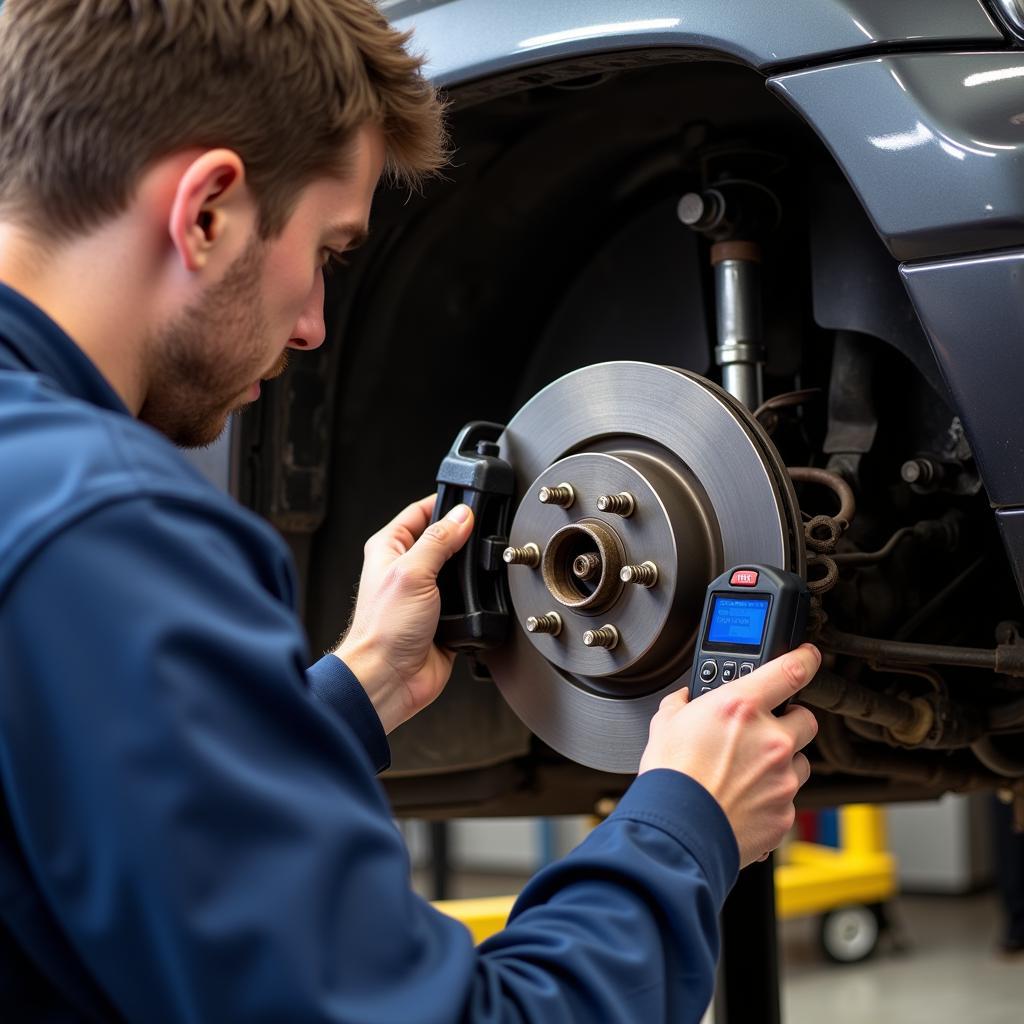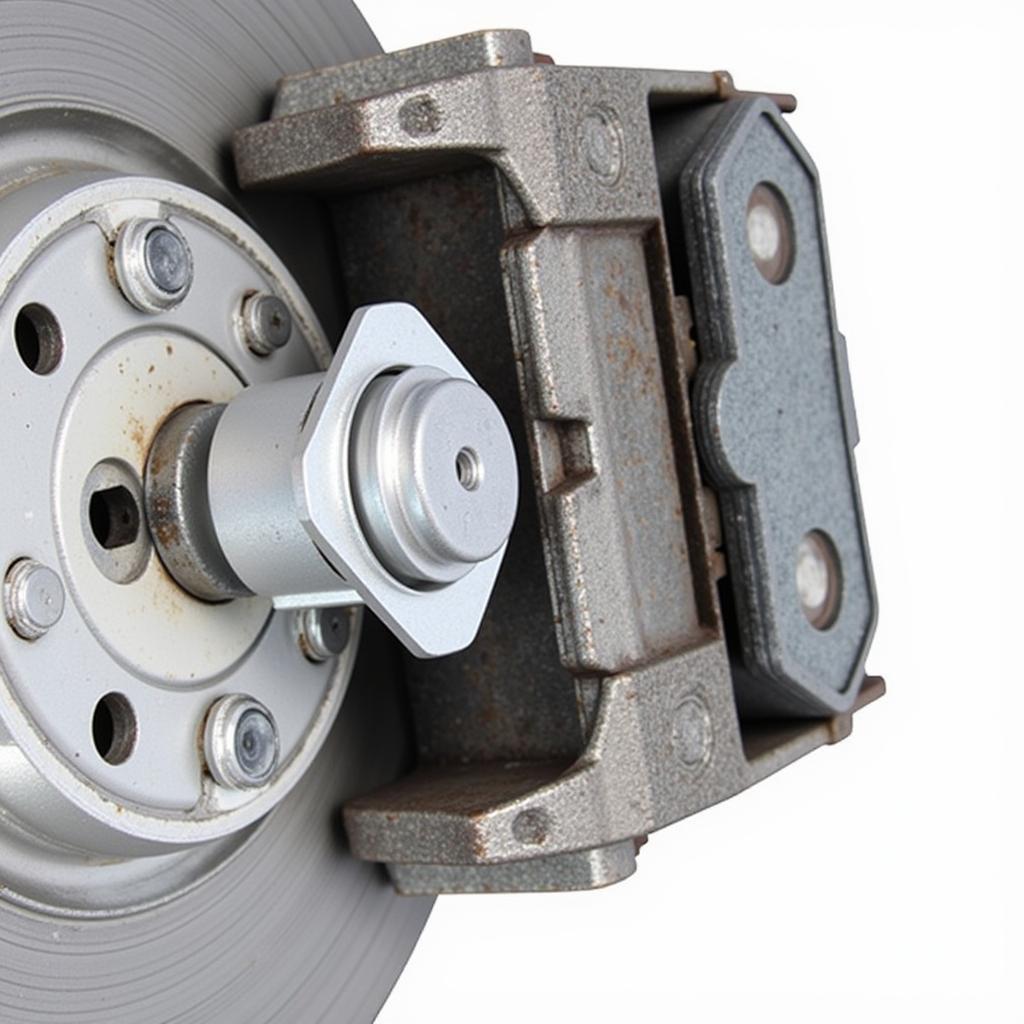Experiencing a glowing “brake light” warning on your 2004 Jeep Grand Cherokee’s dashboard can be unnerving. This signal, often accompanied by the ABS light, indicates a potential issue within your vehicle’s complex braking system. Don’t panic; this guide will walk you through common causes, potential solutions, and when it’s best to call in a professional.
Understanding Your Jeep Grand Cherokee’s Braking System
Before diving into troubleshooting, it’s helpful to grasp the basics of your Jeep’s braking system. It’s designed with multiple components working together to provide reliable stopping power. Key elements include:
- Hydraulic System: This system uses brake fluid to transmit force from the brake pedal to the wheels, engaging the brakes.
- Anti-lock Braking System (ABS): ABS prevents wheels from locking during hard braking, maintaining steering control and stability.
- Electronic Brake-force Distribution (EBD): EBD optimizes braking force to each wheel based on vehicle load and road conditions, enhancing stability.
- Brake Sensors: Strategically placed sensors monitor various aspects like wheel speed, brake fluid level, and brake pedal position, relaying information to the vehicle’s computer.
Common Reasons Your Brake Light is On
A lit brake warning light is your Jeep’s way of signaling that something requires attention. Here are some common culprits:
1. Low Brake Fluid
Could this be it? Absolutely. Low brake fluid is a frequent trigger for the brake warning light.
Why it matters: Brake fluid is the lifeblood of your hydraulic braking system. A leak or inadequate fluid level hinders proper braking performance.
How to check:
- Locate the brake fluid reservoir under the hood. It’s typically a translucent plastic container with a black cap.
- Check the fluid level against the “MIN” and “MAX” markings.
What to do: If low, add the correct DOT 3 or DOT 4 brake fluid (as specified in your owner’s manual). Important: Never mix brake fluid types! If you’re frequently topping off, suspect a leak and seek professional inspection.
2. Worn Brake Pads
Could this be it? Highly likely. Brake pads have wear indicators designed to trigger the warning light when they thin out.
Why it matters: Brake pads are your first line of defense when stopping. Worn pads significantly reduce braking efficiency and can damage rotors.
How to check: Visually inspect the brake pads through the wheel spokes. Look for a thin sliver of pad material remaining on the metal backing plate.
What to do: Replace worn brake pads immediately. It’s often recommended to replace all four pads simultaneously.
3. ABS Issues
Could this be it? Possibly. When the ABS light illuminates alongside the brake light, it often points to an issue within the ABS system itself.
Why it matters: A malfunctioning ABS can lead to reduced braking effectiveness, particularly on slick surfaces.
How to check: Unfortunately, diagnosing ABS issues typically requires specialized diagnostic tools.
What to do: If you suspect an ABS problem, it’s best to visit a qualified mechanic equipped to diagnose and repair ABS systems.
4. Brake Light Bulb Failure
Could this be it? While less common, a burned-out brake light bulb can sometimes trigger the warning light.
Why it matters: A functioning brake light is crucial for signaling to drivers behind you that you’re slowing down, preventing accidents.
How to check: Have someone press the brake pedal while you visually inspect all brake lights for proper illumination.
What to do: Replace any burned-out bulbs with the correct type for your Jeep Grand Cherokee.
5. Faulty Brake Light Switch
Could this be it? A possibility, but less likely than other causes. The brake light switch activates your brake lights when the pedal is pressed.
Why it matters: A malfunctioning switch can prevent your brake lights from working properly, increasing the risk of rear-end collisions.
How to check: Testing this switch requires some electrical know-how and a multimeter.
What to do: If you suspect a faulty switch, consult a mechanic for diagnosis and replacement.
 A mechanic inspecting the brake system of a 2004 Jeep Grand Cherokee
A mechanic inspecting the brake system of a 2004 Jeep Grand Cherokee
When to Seek Professional Help
While some brake light issues can be addressed with basic DIY maintenance, others require specialized knowledge and equipment. Here’s when it’s crucial to consult a professional:
- You’re uncomfortable with DIY car repair: Brakes are critical for safety; don’t hesitate to call in a pro if you’re unsure.
- You suspect an ABS problem: Diagnosing and repairing ABS systems requires specialized tools and expertise.
- You’ve added brake fluid but the light remains on: This often signals a leak, requiring professional inspection and repair.
- The problem persists after trying basic troubleshooting: Don’t ignore a persistent brake light; a mechanic can pinpoint the issue.
Expert Insights
“Many car owners underestimate the importance of regular brake system maintenance,” says seasoned mechanic John Miller. “A simple brake inspection every 12,000 miles or during an oil change can catch minor issues before they escalate into costly repairs. Remember, a well-maintained braking system is crucial for your safety on the road.”
Conclusion
A glowing brake light on your 2004 Jeep Grand Cherokee shouldn’t be ignored. By understanding common causes and conducting some basic checks, you can often identify the issue. However, don’t hesitate to seek professional help when needed. Prioritizing your Jeep’s braking system ensures your safety and the safety of others on the road.

